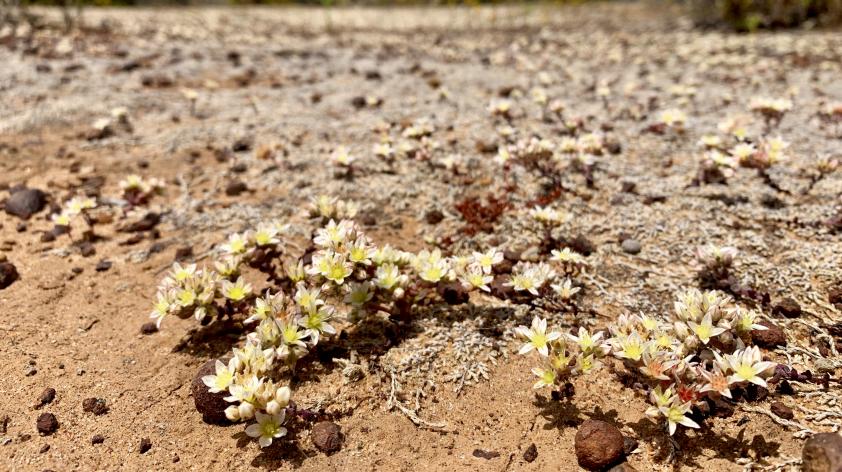
Rare Plant Reintroduction: Dudleya brevifolia – Part 2
It’s been five months since we planted our Dudleya brevifoliacorms into sandstone bluffs along the San Diego coastline. We’ve had some success and some disappointment, and we’ve gleaned valuable insight along the way. (Read Part 1 of this blog here.)
It can be difficult to define success and failure when analyzing the results of an experiment like this, and when introducing plants or animals into the wild, we must be prepared for both. While success should be celebrated, failure is also an important facet of experimentation, it teaches us what doesn’t work, and why.
In January 2019, 46 corms that we grew from wild seeds were reintroduced into habitat near one small and imperiled wild population. This reintroduction would effectively double the population of corms at this location. You can think of corms as bulbs, which grow aboveground in ideal conditions, and go dormant underground in adverse conditions.
The exact location of each introduction was carefully chosen, recorded, and marked with an underground pit tag. We monitored the corms using a tag reader, allowing us to find the exact location of the reintroduced plant when we returned to monitor.
Transplanting Dudleya brevifoliacorms had never been attempted before, and we weren’t sure how they would respond. Many of the factors that could contribute to their success or failure were unpredictable.
While we tend to think of animals as rather independent life forms, able to seek out food and water, defend themselves, and reproduce, plant survival is often conditional upon factors out of their control. In contrast to animals, plants are rather dependent on whatever is around them. Many plant species have symbiotic relationships with fungi in soils that are necessary for nutrient uptake. Many are completely reliant upon pollinators to reproduce. All plants are stationary and unable to escape from herbivory, human impacts, and abiotic factors like weather or poor soil conditions.
Because this was our first reintroduction of Dudleya, we used an experiment to test factors that could help us learn the best methods. Would large corms be more successful than short? Would any corms survive, or should we consider using seeds? Even if the experiment failed, we would learn from it.
We first noticed the emergence of some tiny Dudleya leaves after about a month. Over the course of the next few weeks we observed the aboveground growth of nine reintroduced individuals, but we also began to notice some potential problems.
At one point, an introduced individual growing aboveground completely disappeared. We were able to find its planting location using the tag reader, but all visible growth was gone. We suspect herbivory, but don’t know if this will lead to the death of the corm. We won’t know how it responds until next growing season.
On another visit, we noticed a large amount of disturbance in the soil around some of the introduced plants. Shoe prints were visible and some of the wild adult Dudleya nearby had been smashed. Someone had crossed the barrier, likely to take a panoramic photo, and had stepped on some of the inconspicuous plants, destroying any hope that they would reproduce this season.
In one section of the introduction, small nails marking our planting locations were kicked up and removed. Was this done by vandals, or “good Samaritans” just trying to pick up trash? Either way, several of our introduced corms were damaged.
We noticed signs of human impact on every visit. Large, wild plants are inadvertently kicked or stepped on, delicate sandstone bluffs are damaged, trash is often left behind, marring the pristine habitat. Even at a well-patrolled preserve, in an affluent neighborhood, with signage and barriers in place, the impacts are substantial.
There are many potential hurdles plants must overcome to survive reintroduction, but it’s become apparent that the biggest threat and the highest hurdle for our Dudleya plants is humans.
Despite all the discouraging things we’ve seen over the course of five months, we’ve also observed some remarkable things.
We’ve seen numerous tiny Dudleya brevifolia sprout from a barren landscape that was devoid of other life. We’ve met many enthusiastic citizens interested in saving this resource. We even had one of our introduced Dudleya brevifolia produce flowers!
Here’s what we’ve learned so far:
- Around 20% of our corms appear to have survived the reintroduction. This number could increase if some are established underground but not displaying aboveground. It could decrease if some corms do not survive the hot dry summer. We’ll have a better idea next growing season.
- In order to increase and stabilize this wild population, we’ll need to grow and introduce more corms! Corms aren’t particularly difficult to grow ex-situ. We can collect more wild seeds and continue to reintroduce, on a larger scale.
- Larger corms are likely more successful than smaller corms in reintroductions based on our initial observations, but we need more data and we’ll understand this relationship better after next year’s growing season.
- We must continue to work with land managers to educate the public about the perils of this tiny plant, and to better protect this habitat.
I think this was a very successful first step, and we’re now better prepared to make significant strides in ensuring this species never goes extinct.
If anything, these tiny plants have proven how resilient they can be, and if we continue to actively contribute to their conservation, I believe we can ensure that they will be growing in this beautiful locale for generations to come.













